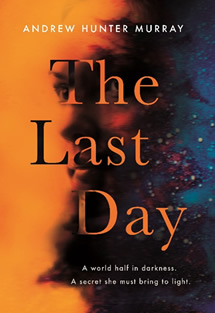Reviewed by Robert Goodman.
By Andrew Hunter Murray, Penguin, $32.99.
 Andrew Hunter Murray’s debut novel, The Last Day is one of an interesting new strain of post-apocalyptic dystopian thrillers. Unlike standard clifi apocalypses which project forward from current predictions of climate catastrophe to imagine a post-climate change world, these books posit a completely separate form of environmental catastrophe. In Greg Egan’s 2019 novella Perihelion Summer, a passing micro-black hole drags the earth into a closer orbit to the sun, spiking temperatures across the world and sparking a global collapse. Something similar drives the high concept behind The Last Day. When the book opens, thirty years have passed since some random cosmic event slowed the Earth down and eventually stopped it from turning. The Stop left half the world in darkness and the much of the rest baking hot, the only relief to be found in the higher latitudes and edge zones. Dystopia, naturally, follows.
Andrew Hunter Murray’s debut novel, The Last Day is one of an interesting new strain of post-apocalyptic dystopian thrillers. Unlike standard clifi apocalypses which project forward from current predictions of climate catastrophe to imagine a post-climate change world, these books posit a completely separate form of environmental catastrophe. In Greg Egan’s 2019 novella Perihelion Summer, a passing micro-black hole drags the earth into a closer orbit to the sun, spiking temperatures across the world and sparking a global collapse. Something similar drives the high concept behind The Last Day. When the book opens, thirty years have passed since some random cosmic event slowed the Earth down and eventually stopped it from turning. The Stop left half the world in darkness and the much of the rest baking hot, the only relief to be found in the higher latitudes and edge zones. Dystopia, naturally, follows.
Overnight, alliances that had lasted centuries collapsed. The relationships shared at half the planet’s distance, the web of connections promoting ideology above latitude: all came to an abrupt stop. Geography became the only factor affecting a nation’s prospects.…
Then, of course, had come the collapse, and a few years after that, the turbulent Reconstitution.
Elle Hopper is scientist living on that post-apocalyptic staple – a rig in the middle of the Atlantic. She is a civilian, pursuing research into how ocean currents were affected by The Stop when she is dragged back to London at the request of her dying mentor. Edward North was instrumental in the establishment of the authoritarian, dystopian government but fell out with its leader and besides a stint teaching at Oxford (where he met Hopper), he has been living in exile. But he has a secret, one he wants to share with Hopper, and one the authorities will kill to protect.
Following this set up is what can only be described as a dystopian state thriller. This type of narrative is one in which an individual tries to stay one step ahead of a relentless, all-seeing and powerful secret police force, following a trail of breadcrumb clues as time ticks down to something worse (another good recent example of this, although with a completely different premise, is Ben Winters’ Golden State). Murray keeps the pages turning with cliffhangers and close scrapes as Hopper slowly draws closer to unearthing the secret that North has been hiding.
Hopper herself, despite the scrapes she finds herself in, is no action hero. Armed only with a tragic backstory, some potentially helpful connections and an inquiring mind that pushes her to discover the truth, she keeps digging and striving despite danger to herself and those around her. She is mortal – she gets beaten up, threatened and injured – but pushes herself to carry on in service of her quest.
Much like John Lanchester’s 2018 dystopia The Wall, it is hard not see books like this partially as a response to Brexit. In The Wall, a literal concrete wall built around the coast was a physical manifestation of fortress Britain. In The Last Day, Britain has once again become a global power, mostly by the luck of the stopped Earth but then by aggressive, single-minded violent management which put Britains first. The British government has, of course, made sure that its borders are secure:
Below the water, heaps of metal lurked – the ships of the last century, scuttled to drag down any that approached today. Britain had locked itself away while the rest of the world fell apart.
The British government has used this new found power to push back into Europe, consigning people that it considers undesirable to work in the fields of western Europe now known as the Breadbasket.
Along the middle of the road, a phalanx of people, perhaps ten across, was half walking, half marching towards the river… They were every shape, every height, very colour of skin. Their clothes were in poor condition, loosely orbiting a rough uniform of off-white shirts and trousers; many did not fit…
Up and down the column, mounted soldiers in black, fitted with helmets and truncheons…
The ceremony was called the Winnow. It was one of Davenport’s little bits of street theatre, designed to keep people quiescent by reminding them what waited for anyone who committed a serious enough crime
Hopper’s journey only works, however, if there are people who do not buy into this philosophy and the violence and repression that underlies it.
By creating an external cosmic catastrophe, Murray gets to deal with the potential consequences of climate change without having the extrapolate from the real thing. Questions that Hopper and the people she encounters have to deal with like whether it is still advisable to have children. Or how countries that benefit from climate change might deal with climate refugees. Or how much technology and forward planning can help us mitigate and deal with the changes that we know are coming. In particular, the book tackles the intersect of politics and science:
‘Everyone says they’re opposite endeavours, politics and science; that one deals with truth and the other with perception. It’s not really true. Science doesn’t change with perception, of course. Photosynthesis doesn’t alter based on public opinion. That much is true. But what we think is possible, what is… acceptable to believe: that is another matter….
‘What about things that are true but unacceptable? So we accept them? Of course we don’t. We are rational agents, acting with self-interest.’
The Last Day takes a standard thriller structure and some well-worn dystopian tropes and drops them into a high concept environment. Murray builds his world organically and manages to deliver a page turning plot in a well realised world without falling too much into exposition. Most importantly, he makes the best use of his dystopian scenario. Using his setting, characters and situations to dig into and explore current issues in an accessible and entertaining way.
This review was first published on Newtown Review of Books.
This and 500 more reviews can be found at www.pilebythebed.com.










